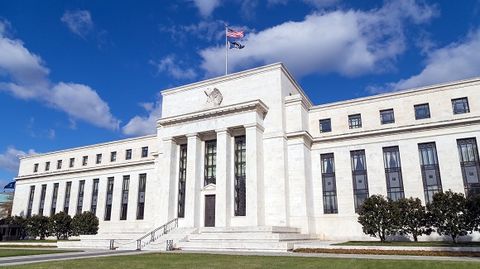Markets in Europe lost ground yesterday after it was announced that the EU was proposing a mandatory phaseout of Russian coal imports in response to the atrocities committed by Russian forces in and around Kyiv, although the FTSE100 managed to finish the day higher.
US markets also had a difficult session, sliding back on comments from Fed governor Lael Brainard and Mary Daly of the San Francisco Fed, who both suggested that the Fed could start the process of reducing the size of the balance sheet at the same time as raising rates next month.
Yesterday’s comments put into sharp relief the concerns investors have, that in looking to rein back inflation, the Fed might overplay its hand and tighten too aggressively and tip the economy into recession. This concern looks set to manifest itself into a sharply lower open for markets in Europe this morning.
Today’s Fed minutes should offer some additional insight into the thinking of all Fed policymakers into this part of the Feds normalisation process.
As expected, the Federal Reserve raised rates at its March meeting by 25bps, although the decision wasn’t unanimous in that St. Louis Fed President James Bullard argued for a 50bps rate rise.
His argument was that the Fed funds rate needed to be at 3% by year end, (it’s at 0.5% now), due to core PCE being over 4% higher than the Feds target rate of 2%.
While he is probably in a minority on this one point now, the Fed has indicated it wants to see another 6 rate rises this year, and that at a minimum, one of these is likely to be a 50bps move, which now looks more than likely to happen next month.
Today’s minutes should give us an indication as to how much events in Ukraine tempered the Fed’s response last month in terms of the size of the increase in rates, and whether there was a temptation to go harder amongst other members and join Bullard in going for more than 25bps.
The FOMC upgraded its inflation forecast for 2022 to 4.3% from 2.6%, and in 2023 to 2.7% from 2.3%, while downgrading GDP to 2.8% in 2022 and 2.3% in 2023. The upward adjustment to the inflation forecast while significant was well below the current PCE deflator level of 6.4%, and looks a significant underestimate given recent sharp moves higher in the headline CPI rate, which could go move well above 8% next week.
Various Fed policymakers have indicated that a 50bps move is likely to be on the table in May, as well as at future meetings, and when you have the likes of a dove like Neel Kashkari of the Minneapolis Fed arguing the Fed would probably need to be more aggressive, then the calculus looks set to shift rapidly in the coming months if inflation proves to be much more persistent.
Yesterday’s comments from Fed governor Lael Brainard and Mary Daly of the San Francisco Fed suggest that FOMC members are becoming even more concerned about inflation with both suggesting balance sheet reduction could also happen next month alongside a 50bps rate hike.
The reaction of US bond markets to those comments about balance sheet reduction were particularly notable given that the baseline assumption had been that whatever happened with rates, the balance sheet discussion would be left until the end of Q2 at least. The US 10-year yield jumped sharply in response pushing well above 2.5%, un-inverting back above the 2-year yield in the process, which also touched 2.5%. The US dollar also rose sharply hitting a three-week high against the euro.
Today’s minutes could well offer an insight into the wider discussion around this and how close Fed policymakers are in relation at looking to start this process. Given the recent sharp rises in ISM prices paid data in March, any discussion around this in last month’s meeting, is likely to have moved up the priority list considering recent data.
Higher prices aren’t just a US concern, today’s EU PPI numbers for March are set to hit a new record later today when they rise by 31.6% year on year, and by 1.2% on a month on month basis.
EUR/USD – has broken below the 1.0950 targeting a return towards trend line support from the 2017 lows, at 1.0830. Resistance remains back at the 50-day MA at 1.1185 and last week’s high.
GBP/USD – looks set for a retest of the March lows at 1.3000, on a break below the 1.3060 level. We need to get back above the 1.3180 area. A break below the 1.3000 area argues the risk of a move towards 1.2800, on a break below 1.2980.
EUR/GBP – continues to fall back with the support at the 0.8320 area, with a break retargeting the 0.8280 area. Resistance now comes in at the 0.8420 area, and behind that at 0.8510.
USD/JPY – while neckline support at the 121.30 area, holds we could well see a retest of the highs at 125.10, and the June 2015 highs at 125.85. A break below 121.20 argues for a steeper move lower towards 118.00.
Disclaimer: CMC Markets is an order execution-only service. The material (whether or not it states any opinions) is for general information purposes only, and does not take into account your personal circumstances or objectives. Nothing in this material is (or should be considered to be) financial, investment or other advice on which reliance should be placed. No opinion given in the material constitutes a recommendation by CMC Markets or the author that any particular investment, security, transaction or investment strategy is suitable for any specific person. The material has not been prepared in accordance with legal requirements designed to promote the independence of investment research. Although we are not specifically prevented from dealing before providing this material, we do not seek to take advantage of the material prior to its dissemination.








